This EduRev document offers 10 Multiple Choice Questions (MCQs) from the topic Missing Data (Level - 2). These questions are of Level - 2 difficulty and will assist you in the preparation of CAT & other MBA exams. You can practice/attempt these CAT Multiple Choice Questions (MCQs) and check the explanations for a better understanding of the topic.
Question for Practice Questions Level 2: Missing Data
Try yourself:Directions: Study the table carefully and answer the following question.

Q. If the ratio of the number of selected candidates by Company P in 2009 to that in 2010 is 16 : 9, what is the number of selected candidates by Company P in 2010?
Explanation
The ratio of selected candidates in Company P in 2009 to that in 2010 is 16: 9.
Now, in 2009, the number of selected candidates = 720 x 60/100 = 432
Let the number of selected candidates in Company P in 2009 and 2010 be 16x and 9x, respectively.
Therefore, 16x = 432
x = 432/16 = 27
Therefore, in 2010, the number of selected candidates is
⇒ 27 × 9 = 243
Hence, it is the required result.
Report a problem
Question for Practice Questions Level 2: Missing Data
Try yourself:Directions: Study the table carefully and answer the following question.

Q. What is the difference between the number of selected candidates by Company P in 2007 and that in 2006?
Explanation
According to the question, the required difference is
⇒ (900 × 43)/100 - (674 × 50)/100
⇒ 387 - 337 = 50
Report a problem
Question for Practice Questions Level 2: Missing Data
Try yourself:Directions: Study the table carefully and answer the following question.

Q. If the average number of selected candidates in Company Q in 2008, 2009 and 2010 is 315, what is the number of selected candidates from College Q in 2010?
Explanation
Let the percent of selected candidates from Company Q in 2010 be x%.
Therefore,
Average =  = 315
= 315
210 + 495 + 6x = 945
6x = 945 - 705
6x = 240
x = 240/6 = 40%
Therefore, the number of selected candidates from Company Q in 2010 is
⇒ 600 x 40/100 = 240
Hence, it is the required result.
Report a problem
Question for Practice Questions Level 2: Missing Data
Try yourself:The table shows the number of appeared and qualified candidates (in thousands) in a competitive examination from different states over the years.

Q. If the average number of appeared candidates from UP is 79 thousand and the average number of qualified candidates from UP is equal to the qualified candidates from Delhi in 2015, then what is the ratio of appeared candidates from UP in 2012 to that of the qualified candidates from UP in 2015?
Explanation
Total number of appeared candidates from UP in 2012 = 79 × 4 - (78 + 72 + 88) = 78
Average number of qualified candidates from UP = Qualified candidates from Delhi in 2015 = 14
Total number of qualified candidates in 2015 from UP = 14 × 4 - (13 + 9 + 12) = 22
Hence, ratio of appeared candidates from UP in 2012 to that of the qualified candidates from UP in 2015 = 78 : 22 = 39 : 11
Report a problem
Question for Practice Questions Level 2: Missing Data
Try yourself:The table shows the number of appeared and qualified candidates (in thousands) in a competitive examination from different states over the years.

Q. In 2016, the number of appeared candidates from Bihar, TN and Delhi increased by 20%, 15% and 12% from the previous year, respectively and the number of appeared candidates in 2016 from UP and Odisha decreased by 5% and 4%, respectively. What is the total number of appeared candidates in 2016 from all the given states, if the number of appeared candidates from Odisha in 2015 is equal to 12% more than that of appeared candidates from TN in 2013?
Explanation
Total number of appeared candidates from Odisha in 2015 = 12% more than appeared candidates from TN in 2013 =75 x 112/100 = 84 thousand
Total number of appeared candidates in 2016 from all the given states
= 20% more than appeared candidates from Bihar in 2015 + 15% more than appeared candidates from TN in 2015 + 12% more than appeared candidates from Delhi in 2015 + 5% less than appeared candidates from UP in 2015 + 4% less than appeared candidates from Odisha in 2015
= (95 + 20% of 95 + 82 + 15% of 82 + 94 + 12% of 94) + (88 - 5% of 88 + 84 - 4% of 84) = 313.58 + 164.24 = 477.82 thousand
Hence, total number of appeared candidates in 2016 from all the given states = 477,820
Report a problem
Question for Practice Questions Level 2: Missing Data
Try yourself:The table shows the number of appeared and qualified candidates (in thousands) in a competitive examination from different states over the years.

Q. If in 2013, the number of appeared candidates from Bihar is 9 thousand more than the number of appeared candidates from Odisha in 2012 and the number of qualified candidates from Odisha in 2013 is 125% of qualified candidates from Odisha in 2012, then the number of qualified candidates in 2013 from all the states is what (approximate) percent of that of appeared candidates from all the states in that year?
Explanation
Total number of appeared candidates from Bihar in 2013 = (77 + 9) thousand = 86 thousand
Total number of qualified candidates from Odisha in 2013 = 125% of qualified candidates from Odisha in 2012 = 125% of 12 thousand = 15 thousand
Then, the total number of qualified candidates in 2013 from all the states = (14 + 12 + 9 + 15 + 15) thousand = 65 thousand
And, total number of appeared candidates in 2013 from all the states = (86 + 75 + 78 + 84 + 68) thousand = 391 thousand
Therefore, % of qualified candidates from all the states in 2013 = 65/391 x 100 = 16.62%
Report a problem
Question for Practice Questions Level 2: Missing Data
Try yourself:Directions: Study the data given below and answer the following question.
Five manufacturers P, Q, R, S and T are selling four different products given in the table below. The table contains profit percentages gained on the cost price of these products by different manufacturers (after discount, if any)

Note:
1. The missing values can be calculated using the data given in the question.
2. Cost price of a particular product is the same for all the manufacturers, unless specified.
Q. If the respective ratio of marked prices of product II by sellers R and T is 23 : 24, the discount percentage offered by manufacturer R on selling product II is d% and that offered by manufacturer T on selling the same product is (2d - 4)%, then find the value of d.
Explanation
For manufacturer R of product II:
Let CP = 100x
⇒ SP = 115x = MP - d% of MP
⇒ MP = 100/(100 - d) × 115x
For manufacturer T of product II:
SP = 120x = MP - (2d - 4)% of MP
⇒ MP = 100/(100 - 2d + 4) × (120x)

⇒ 100 - 2d + 4 = (100 - d)
⇒ d = 4
Report a problem
Question for Practice Questions Level 2: Missing Data
Try yourself:Directions: Study the data given below and answer the following question.
Five manufacturers P, Q, R, S and T are selling four different products given in the table below. The table contains profit percentages gained on the cost price of these products by different manufacturers (after discount, if any)

Note:
1. The missing values can be calculated using the data given in the question.
2. Cost price of a particular product is the same for all the manufacturers, unless specified.
Q. The average selling price of product IV by manufacturers R and S is Rs. 1360, and that by manufacturers S and T is Rs. 1340. Find the selling price of product IV by manufacturer S.
Explanation
Let the profit percentage on product IV by manufacturer S be p.
For product IV, let CP = 100x
SP (manufacturer R) = 122x
SP (manufacturer S) = (100 + p)x
SP (manufacturer T) = 118x
122x + (100 + p)x = 1360 × 2 = 2720
(100 + p)x + 118x = 1340 × 2 = 2680
Upon subtracting: 4x = 40
⇒ x = 10 and p = 50%
SP (manufacturer S) = (100 + 50) × 10 = Rs. 1500
Report a problem
Question for Practice Questions Level 2: Missing Data
Try yourself:Directions: Study the table given below and answer the following question.
The Prime Minister of India distributed grains (in tonnes) in different states of India to gain a position in next election. The data of distribution is as follows:
(Total grains distributed = 30,000 tonnes)

Q. What is the difference between the total distribution of grains in Tamil Nadu and that in Goa and Arunachal Pradesh together?
Explanation
Quantity of grains distributed in Tamil Nadu = 6500 tonnes
Total quantity of grains in Goa and Arunachal Pradesh together = 3500 + 4200 = 7700 tonnes
Required answer = (7700 - 6500) tonnes = 1200 tonnes
Report a problem
Question for Practice Questions Level 2: Missing Data
Try yourself:Directions: Study the table given below and answer the following question.
The Prime Minister of India distributed grains (in tonnes) in different states of India to gain a position in next election. The data of distribution is as follows:
(Total grains distributed = 30,000 tonnes)

Q. What percentage of the total distribution of grains in all the states together is the total distribution of grains in rural areas of all the states together, excluding Gujarat?
Explanation
Total distribution of grains in rural areas of all the states together, excluding Gujarat
= 6500 × 50/100 + 3400 × 56/100 + 2500 × 79/100 + 3500 × 57/100 + 78/100 × 4200 + 4700 × 60/100
= 3250 + 1904 + 1975 + 1995 + 3276 + 2820 = 15,220 tonnes
Total distribution = 30,000 tonnes
Required percentage = 15,220/30,000 × 100 = 50.73%
Report a problem
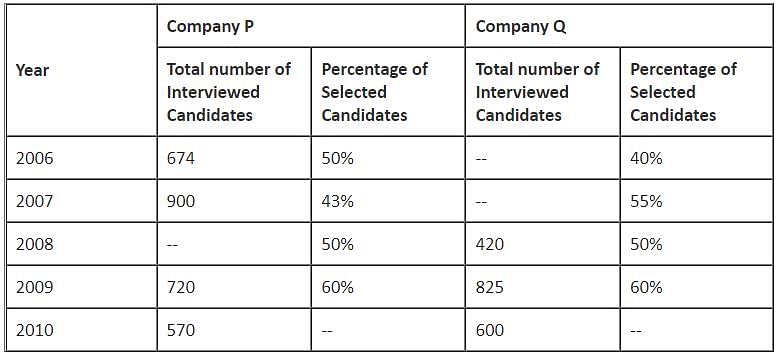
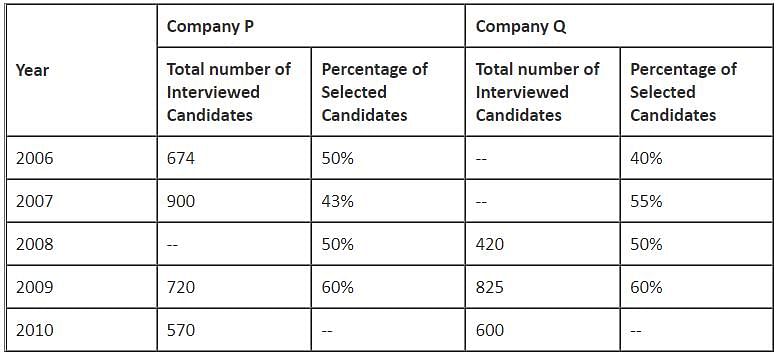

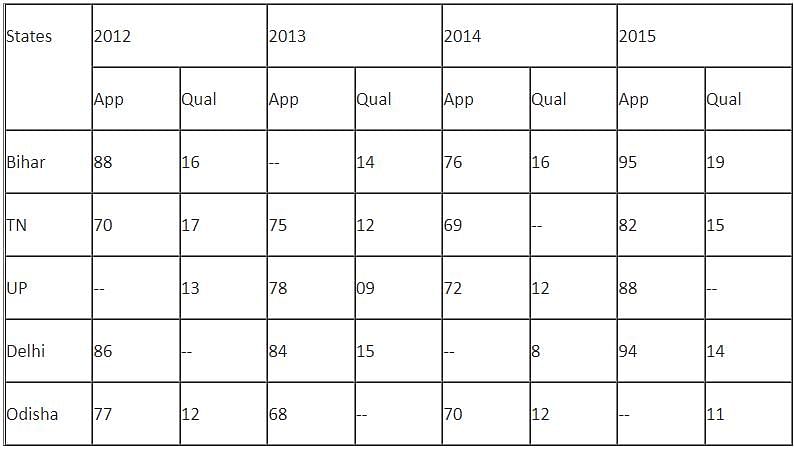
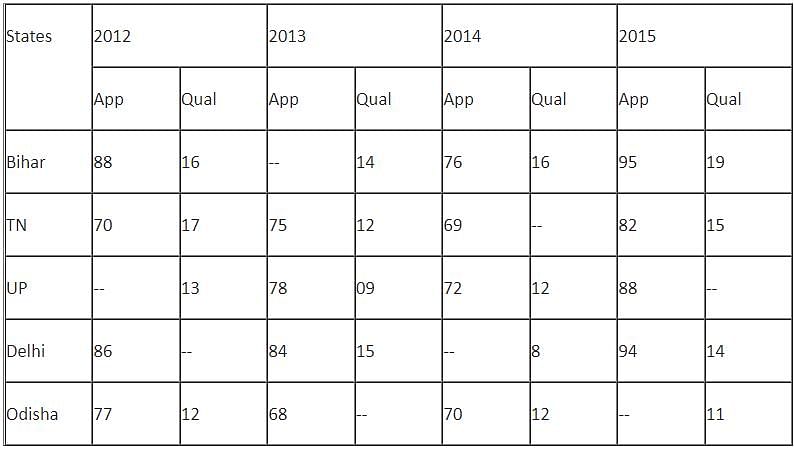

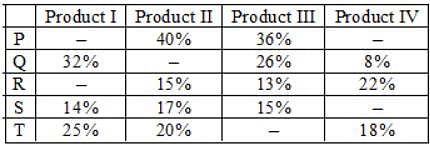
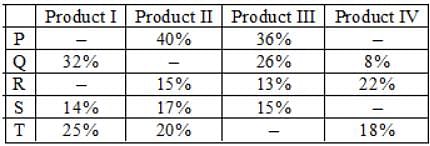

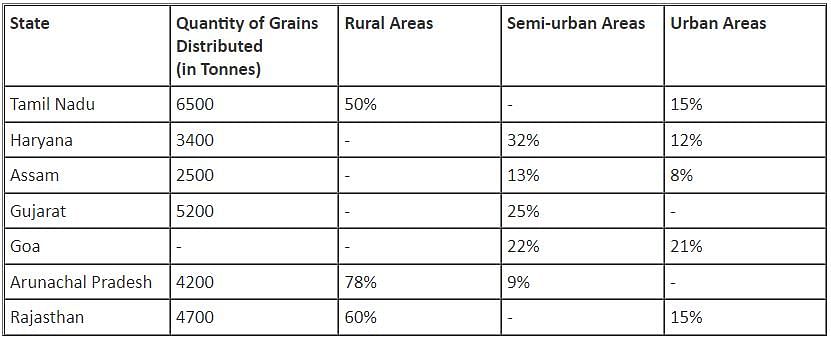


 = 315
= 315
















